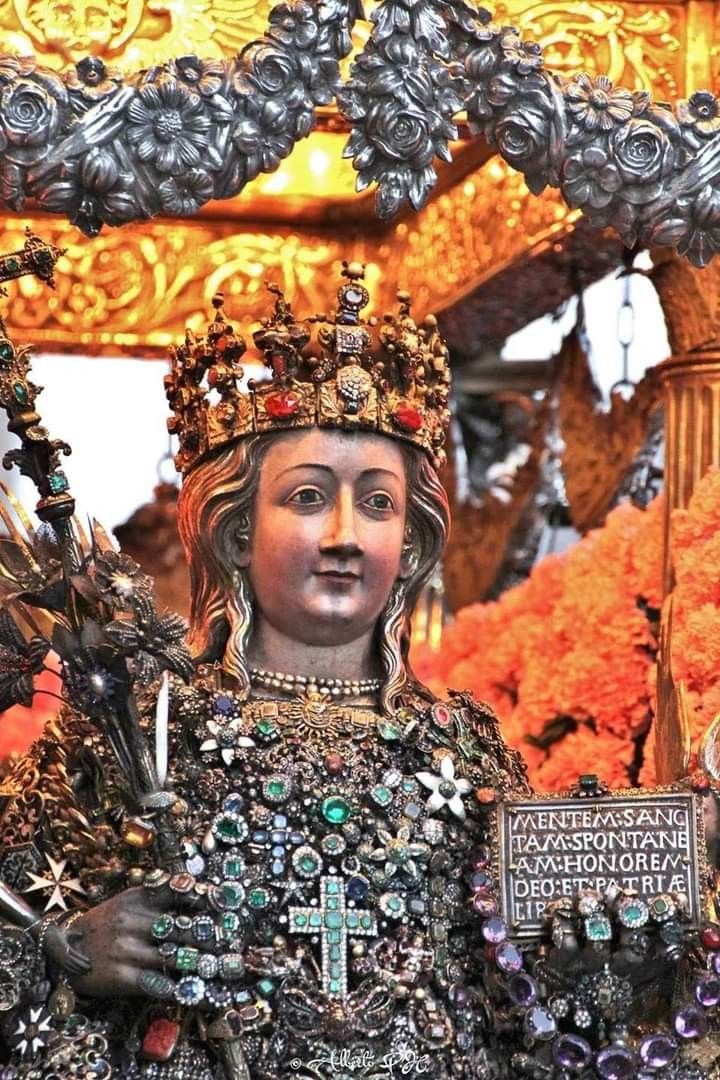
Sant'Agata: The Patron Saint of Catania - Legend and Tradition
Share
Sant'Agata, the beloved patron saint of Catania, is one of Sicily's most venerated figures, and her story is deeply ingrained in the city's culture and traditions. Her feast, celebrated every year in early February, is a grand event that attracts thousands of visitors and locals alike. The story of Sant'Agata, full of sacrifice, courage, and devotion, has transcended centuries and continues to inspire people to this day.
The Legend of Sant'Agata
Sant'Agata’s story is rooted in both historical events and deep religious symbolism. Born in Catania around the year 231, Agata was a young and beautiful Christian woman who vowed to dedicate her life to God. According to legend, her beauty attracted the attention of a Roman official named Quintianus, who was infatuated with her and sought to marry her. However, Agata had taken a vow of chastity and devoted herself to a life of faith. Rejected by Agata, Quintianus, enraged by her refusal, sought to punish her.
Her martyrdom is said to have taken place under the persecution of Emperor Decius, who was known for his violent repression of Christians. Quintianus, who wanted to punish Agata for her faith, subjected her to horrific torture. One of the most famous aspects of her martyrdom is the story of her mutilation. According to tradition, Agata's breasts were cut off, yet she is said to have remained resolute in her faith. Despite her suffering, Agata’s courage did not falter.
Ultimately, Agata died a martyr’s death, and her sacrifice and devotion to God made her a symbol of strength, purity, and resilience. Over time, her martyrdom became the basis for her canonization, and she was recognized as a saint, gaining wide devotion across Sicily and beyond.
Sant'Agata: Patron Saint of Catania
Sant'Agata’s connection to Catania runs deep. After her death, her body was eventually buried in a tomb in Catania, and over the centuries, the city became a center of devotion to her. She is not only the patron saint of Catania but also the protector of the city and its inhabitants. Her protection is thought to shield the city from volcanic eruptions, earthquakes, and other natural disasters.
Interestingly, Sant'Agata is also a patron saint of many other places in Sicily, but her association with Catania is particularly strong. This connection is reflected in the city's religious practices, festivals, and the profound respect for Sant'Agata that continues to this day.
The Feast of Sant'Agata: A Grand Celebration
The Feast of Sant'Agata, held annually from February 3rd to 5th, is the largest religious celebration in Catania and one of the most important in Sicily. The feast combines religious devotion with spectacular processions, music, and festivities that fill the streets of Catania with energy and excitement.
The procession is one of the most significant aspects of the festival. During the event, the statue of Sant'Agata is carried through the streets of Catania, surrounded by thousands of devotees. The procession begins at the Cathedral of Catania, where her relics are kept, and continues through the city's main streets. The statue, draped in flowers and surrounded by candles, is a symbol of Agata’s martyrdom and the strength of her faith.
As part of the celebration, participants often wear traditional costumes and carry candles or other offerings as a sign of their devotion. Many people walk barefoot as a sign of penance, and some even participate in the procession by pushing or pulling the heavy “candelore” (large, candle-lit structures) that are part of the tradition. The faithful often offer prayers, sing hymns, and engage in religious rituals to honor Sant'Agata and seek her protection.
The candlelight procession, which occurs on the evening of February 4th, is especially breathtaking. The streets of Catania are illuminated by thousands of candles, creating a beautiful and somber atmosphere as the crowds move in unity, paying homage to the saint. The entire city comes together in a profound expression of faith, and even non-religious visitors are moved by the spectacle.
The Catania “Festa” Traditions
Throughout the days of the festival, there are many local customs and traditions that celebrate Sant'Agata's protection over the city. Catanese pastries known as “cassatelle” and “catanesi” are often prepared and shared among families and visitors. These sweets, made of ricotta cheese, almonds, and candied fruit, are offered as a symbol of gratitude to the saint.
A particularly unique tradition is the "offerta" (offering), where locals donate various items such as candles, food, and even money in exchange for blessings or for protection from misfortune. The festival is not only a religious observance but also a celebration of community and family ties.
For visitors to Catania, the Feast of Sant'Agata is a powerful and emotional experience. The atmosphere is a mix of devotion, festivity, and the kind of fervor that is characteristic of many Sicilian traditions. The streets of Catania are filled with joy, prayers, and music, and the entire city comes together in celebration.
Sant'Agata’s Legacy
Sant'Agata's legacy goes beyond the celebrations and the religious observances. Her story continues to serve as an inspiration for countless individuals in Catania and around the world. Sant'Agata is not only a symbol of courage and faith but also of resilience in the face of adversity. Her story has been passed down through generations, and her protection continues to be sought by those in need.
Even today, Sant'Agata is a unifying figure for Catania, and her feast is a highlight of the city's cultural and religious calendar. The veneration of Sant'Agata is not just a tradition but a living part of the city's identity, one that binds the people of Catania together and offers a sense of continuity and belonging.
